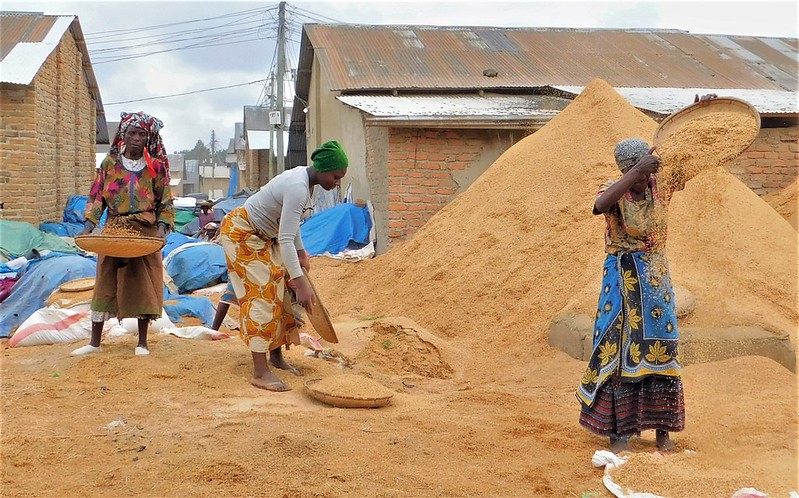As the magnitude, intensity, and frequency of weather extremes increases uncertainty and risks to livelihoods in developing countries, substantial research has been developed on the detrimental effects of weather shocks on the poor and vulnerable facing acute food insecurity.
At the same time, empirical evidence on gender-specific impacts of such shocks on labor use in agriculture remains limited, although more studies focus on gender-differentiated experiences and responses. This is surprising, as more than half of the adult population in Africa south of the Sahara is engaged in agriculture, and farms are largely operated under rainfed conditions and with limited mechanization, making adequate labor input essential to producing food and generating incomes.
To shed more light on this issue, we assessed the impact of heat stress on agricultural labor supply in Tanzania, and also examined sex-differentiated responses. In a study published in Applied Economic Perspectives and Policy, we examine gender-specific responses to heat stress on agricultural labor, disaggregated by key agricultural activities—including land preparation and planting, weeding and harvesting—for different household types, including dual-adult versus female-only households in Tanzania.
Women in Tanzania devote about twice as many hours as men to domestic tasks such as fetching fuel and water, with both activities more prone to climatic risks. Women’s dual roles in the household, their limited access to resources, coupled with growing local and international migration of spouses or sons for non-farm jobs tend to increase their vulnerability to climatic risks and limit their already constrained adaptive capacity to heat stress further.
But what is heat stress? Heat stress occurs when the human body is unable to maintain a healthy temperature in response to a hot environment. Consequences include higher body core temperature, sickness and loss of concentration. Heat stress can lead to fainting and even death. The U.S. Department of Labor notes that workplaces with temperatures above 21 degrees Celsius (70 F) can constitute a heat hazard, but there is no common agreement for a threshold temperature that constitutes heat stress in the workplace.
To estimate the impact of heat stress for those working in agriculture in Tanzania, we use degree days, using a temperature of 29 C as the threshold for heat stress during the main rainy season, which is also the key growing season of maize, Tanzania’s main staple crop. Above this threshold, significant detrimental effects on plant growth and maize yield have been documented, and adverse impacts on humans from heat stress can also be expected.
We employ an econometric model using gender- and activity-specific agricultural labor data from the Tanzania National Panel Survey (NPS), collected over three rounds between 2008 and 2013, as well as gridded weather data. The resulting dataset comprises a total of 6,502 observations over time of households that cultivated at least one plot with any crop during the long rainy season of the respective year spanning March to May.
Our main results suggest that heat stress exerts heterogeneous effects by gender, agricultural activity, and household structure. Following a heat stress episode, males are likely to reduce their family labor supply by 1.4 days per hectare, while female family labor supply is not statistically affected. Heat stress also reduces both male and female hired labor, possibly due to lower labor productivity and lower expected yields. On the other hand, when exposed to heat stress, households with only adult females increase their family labor by 1.5 days per hectare.
The results by agricultural activity show that heat stress reduces male family labor supply by 0.36 days per hectare for weeding, 0.38 days per hectare for land preparation/planting and 0.44 days per hectare for harvesting. While males decrease their family labor on different activities when exposed to heat stress, females show no statistically significant change in any activity. In addition, the heterogenous results for hired labor highlight that hired male labor supply declines by 0.02 days per hectare for land preparation/planting, 0.03 days per hectare for weeding and 0.02 day per hectare for harvesting. In contrast, hired female labor supply decreases by 0.11 days per hectare for land preparation/harvesting. Heat stress also reduces female hired labor for weeding by 0.03 per hectare, with no change on labor intensity for harvesting.
Why do men’s and women’s responses to heat stress events during the main growing season differ? We expect that women’s lower access to key assets and productive resources in agriculture, as well as their limited mobility, leaves agricultural labor as one of their key productive resources, resulting in women persevering in providing labor despite high temperatures. We also suspect that women’s continued labor contributions may be related to physiological, sex-specific differences in body reaction to heat. Studies have indicated that women tend to have lower sensitivity to warmer thermal environments than men.
Our findings suggest that a broadening of coping mechanisms and response options for women farmers is needed to attain Sustainable Development Goal (SDG) 5 on gender equality and SDG 13 on climate action.
Further research and more extensive data collection are needed on the role of different pathways to heterogeneous responses by gender under diverse environmental conditions, including extreme climate events. Only then would we know if the heat truly never bothered women.
Yeyoung Lee is a PhD student in the Department of Agricultural, Food, and Resource Economics at Michigan State University; Carlo Azzarri is a Senior Research Fellow with IFPRI’s Environment and Production Technology Division (EPTD); Claudia Ringler is EPTD Deputy Director and the coordinator of the Gender, Climate Change, and Nutrition (GCAN) Integration Initiative. This post first appeared on Agrilinks.
This work was supported by the U.S. Agency for International Development (USAID).







